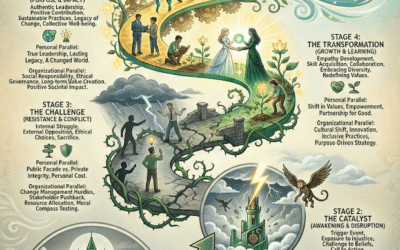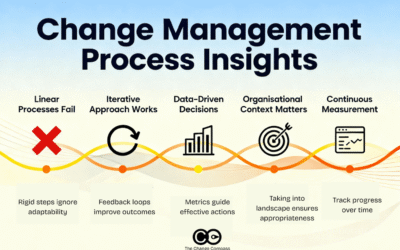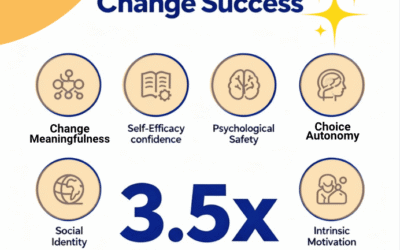In business literature having senior leader sponsorship and buy-in is always highlighted as one of the most if not the most important factor in determining successful initiative outcome. It is touted that without senior leaders to drive the initiative, it is difficult to get traction. The respective senior leaders that own the initiative are identified as the most important stakeholders to engage. As a result, most project managers and change managers spend significant amount of time aligning and influencing the senior leader.
What happens if your particular senior leader(s) are not along the journey, do not engage employees, or are simply absent? Sounds familiar? Does this mean that the initiative will definitely fail? According to research that McKinsey and others have conducted yes there will be a significant risk of failure. So what is one to do in this situation? In fact, in our recent change practice benchmarking study (click here to find out more) many respondents stated that their biggest challenge is to influence senior stakeholders.
Project or change managers will most likely not have the hierarchical status in the organization to influence senior stakeholders based on power or rank. However, do not give up. There is another way …. using soft power. What is soft power? In the field of international relations, soft power is the ability to attract or co-opt rather than coerce (hard power) as a means of persuasion (according to Wikipedia). It is having the ability to influence the behavior or thinking of others through the power of attraction and ideas.
Across the globe some countries are great at using soft power to influence other nations. How? Having strong business brands, artists/designers/musicians who are popular, etc. People all over the world are influenced by soft power through the brands they interact with every day. Apple users interact with their iPhone, iWatch, iPads or iMacs and know its Californian ideals. K-pop music lovers across Asia are influenced by the fashion trends from Korea. Ikea furniture owners experience a piece of Sweden when they walk into an Ikea store, Swedish food, Swedish minimalist design, and modern sensibilities.
So how do we leverage soft power to influence a range of stakeholders including senior stakeholders?
- Leverage your ‘popular stars’. Just as Taylor Swift and Eminem popularize trends and attitudes across the global audience, leverage your organization’s stars. They can be popular bloggers on your internal company social networks such as Yammer. They can also be well-respected figures who have established famous personal brands that are not necessarily the most senior. They can have interesting job titles or particular insights, or are just well-connected. Enlist these figures to help you influence your stakeholders through their presence and visible actions.
- Design an effective internal marketing campaign. Global artists weren’t born popular. They are popularized by marketing machines. Don’t be shy about marketing your selected stars and their messages. Leverage the various corporate channels to market their messages, including intranet articles, posters, emails, videos, blogs, talks, etc. Work on your branding consistency, consistency of messaging, and ensure there is an alignment of different communication channels used.
- To influence key stakeholders such as senior executives, conduct detailed social network analysis. Social network analysis is the mapping and measuring of relationships and flows between people, groups and organizations. Interview those who are close to the chosen targets and start to map out those who are connected and how they are connected. Identify and leverage the targeted network to influence your senior executives. Find out what turns them on and what their pet peeves are. Then, leverage your selected network to influence.
- Attract your stakeholders. Soft power is not about coercion or using carrot or stick. It is about attracting someone to your perspective. How do we do this? From a messaging perspective, appeal to the emotional core of what the stakeholders are attracted to, rather than relying purely on logical arguments. For example, if there is a history of employees jumping in to help one another in times of crisis, then leverage this history and theme to arouse the emotional connection. Tie your message to this theme. Also, work on your visual attraction. Use video imagery, infographic, photographs, and charts to tell a compelling and memorable story. Your stakeholders will remember these a lot more than a long speech or an article.
- Create and leverage your change champions network. In the new world, employees no longer only look to their leader for instruction and information. They leverage their social network to stay informed and engaged. A good change champion network with members that are carefully selected can do just this – pollinate, broadcast and engage a broad range of audience. An effective change champion network that is well-supported can drive significant change across the organization. There are examples of initiatives with poor senior leader sponsorship but have resulted in significant impact due to its change champions at various levels.
Ghandi popularized a non-violent struggle against Great Britain’s colonization of India. Using peaceful means, Ghandi managed to empower the masses to overthrow a dominant superpower. Martin Luther King is another fantastic example of the power of soft power. Using his oration and people motivation skills he was able to amass a large number of people to march for civil rights. This is the magnitude of soft power. While for organizations we may not have such grand ambitions for initiatives, it is worth calling out that one should not underestimate the force of soft power. For Generation Z hierarchy and coercion will not work as well as for previous generations. They want to be inspired to change the world. As a result, how we influence and drive change initiatives will also need to change – from that which is focused on top-down command and control to one that leverages soft power.
—————————-






